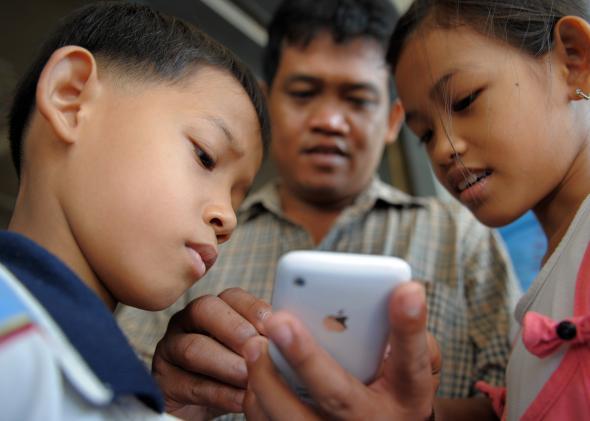Any self-respecting skeptic has to be careful with the word educational. Thousands of games in the iTunes App Store describe themselves as “educational,” but are they? On TV, preschool shows declare that it’s “learning time,” but is it? Given the marketing hype, it can be pretty hard to write about an educational anything without using quotation marks.
New survey results released Friday don’t necessarily solve the problem, but they do take the marketers out of it. Instead, parents are in charge of the labeling. The survey, Learning at Home: Families’ Educational Media Use in America, asked more than 1,500 parents of children 2 to 10 years old to disclose details about digital media and TV use in their households. Many questions centered on whether media helped their children learn. One section, for example, asked parents to consider media products such as DVDs, online videos, or games and focus on those “that teach some type of lesson, such as an academic or social skill, or are good for a child’s learning or growth.”
The results show parents are no dummies (as a mother myself, that’s a reassuring discovery), but they also raise questions about how to up our game, especially when it comes to the apps that are attracting so much of our offspring’s attention.
Parents exhibited the highest level of discernment around television shows. When asked to rate a list of shows and games on a scale from “very” to “not at all” educational, Sesame Street received high ratings, while SpongeBob SquarePants floated near the ocean floor, closest to the “not at all” category. The finding is not surprising but undoubtedly a relief to Sesame Workshop, since Sesame Street was designed to promote learning, employs researchers and writers to review developmental science when writing new curricula each year, and has been the subject of dozens of studies about its effectiveness. (Full disclosure: I am working on an early literacy project with the Joan Ganz Cooney Center, which is a research institute within Sesame Workshop and the publisher of the Learning at Home survey.)
Parents’ low grades for SpongeBob also align with the evidence. Over the years I have studied children’s media, I’ve seen no evidence that SpongeBob’s writers, aiming for laughs, are trying to be comprehensible to young children (or many of us adults, for that matter). In a 2011 study at the University of Virginia, SpongeBob was associated with negatively affecting 4-year-olds’ abilities to focus on tasks and follow directions immediately after watching. But that hasn’t stopped marketers from putting SpongeBob and his googly eyes on sippy cups and size-3T pajamas as if the show is meant for preschoolers.
On digital games, parents’ perspectives were less cut-and-dried. The survey asked about Angry Birds and Minecraft, digital games that emerged on the scene only a few years ago. Among parents who said they were familiar with the games—and for Minecraft, that wasn’t many—the majority rated them fairly low on the educational scale. (I’ve written in this space before about my love-hate relationship with Minecraft, and I wonder if the super-sucked-in, never-ending nature of the game is trumping its creative potential in parents’ minds.)
Apps didn’t fare too well in the survey, either. Even among parents who use mobile educational content weekly, fewer than 40 percent said their children learned “a lot” about any subject (reading, math, healthy habits, etc.) using games, videos or apps on mobile devices.
The majority of parents surveyed said they want help being choosy: Fifty-five percent want more information from experts on how to find educational TV shows, games and websites. Those of us who cover kids’ media for a living are well-aware of resources such as Common Sense Media and Children’s Technology Review, but the survey didn’t ask whether parents also knew about these resources. Instead, it showed that 50 percent of parents come across “educational” media by browsing, and 40 percent get suggestions from teachers. Nearly half of parents wished they had more information on whether digital media was good for their children’s development.
In the world of nutrition, it took several decades and reams of new science to get smarter about eating. Years ago there was a panic over cholesterol; then it became clear that we needed to distinguish between “bad cholesterol” and “good cholesterol.” Once, people were on a crusade to limit fat; now many experts emphasize that simply going “nonfat” while bingeing on carbs could lead to more weight gain, not less.
We need a corollary education about what is “educational,” and at the end of Learning at Home, a series of unusual questions give me hope. Vicky Rideout, the author of the survey, asked parents to consider how children reacted after using various types of media. It’s one of the first attempts I’ve seen in a national survey to quantify what happens beyond the screen. Seventy-seven percent of parents said their kids asked questions based on content they saw or played with, and 61 percent of kids asked to do an activity or project inspired by what they experienced. These were “actions taken,” Rideout wrote, “a result of educational media.”
In the debates over what makes media “educational,” these kinds of actions are rarely considered, but they should start edging their way into the conversation. Maybe more research on actions taken after screen time could help us arrive at a “good cholesterol” moment for media and kids.
Future Tense is a partnership of Slate, New America, and Arizona State University.
